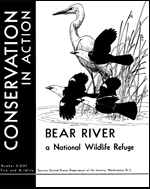United States Fish and Wildlife Service

United States Fish and Wildlife Service: Publications
Date of this Version
2007
Abstract
The primary habitat management objective for the three refuges of the Willamette Valley NWR Complex is to provide high quality forage for wintering Canada geese. To accomplish this, much of the land within the refuge is managed for grass production involving applications of herbicides, fungicides, and fertilizers. Other agrochemicals such as insecticides are applied to agricultural land outside the refuge. Some agrochemicals used in the area have the potential to enter aquatic habitats of the refuge and could impact species such as amphibians, turtles, or the federally-listed Oregon chub. The objective of this investigation was to sample both biotic and abiotic matrices and use a weight-of-evidence approach to determine if agrochemicals used on or around the refuge pose a risk to aquatic species.
This investigation included seven components: 1) evaluation of pesticide use practices; 2) collection of continual water quality measurements; 3) water sampling; 4) in-situ bioassay; 5) analysis of blood plasma from carp and turtles for endocrine-disrupting compound exposure; 6) fish health assessment; and 7) fish tissue analysis for organochlorine pesticides. The components of the study were used as individual lines of evidence to evaluate risk of agrochemicals to aquatic organisms on the refuge. Multiple lines of evidence create more confidence in making decisions suitable for refuge management because the approach considers all the information gathered from the investigation. By framing the assessment with this weight-of-evidence approach, risk to the receptors of concern and organizational levels is more clearly evident and the information can be used in carrying out the Fish and Wildlife Service mission to protect and conserve natural resources.
The pesticide monitoring component of this study indicated that there could be effects to aquatic communities from exposure to atrazine and chlorpyrifos. The greatest potential impact is at Brown Creek which reflects a source of pesticides outside the refuge while Muddy Creek pesticide concentrations indicate sources from both on- and off-refuge.
Nutrient monitoring indicated that several forms of nitrogen and phosphorus exceeded aquatic life criteria in three creeks sampled with the greatest potential for impact at Gray Creek (Cattail Pond), Brown and Muddy Creeks. Sources of nutrients appear to be from both on- and offrefuge.
The hormone values measured in biotic samples from refuge sites were within normal ranges except for western pond turtles at Finley National Wildlife Refuge, where higher testosterone values were observed in females and the female hormone ratio was atypically low compared to reference turtles. This indicates exposure to some type of antiestrogenic compound that blocks the conversion of testosterone to estrogen. All other parameters measured (health, histopathology, and analytical concentrations) were similar to reference values or considered within normal ranges. Only the two non-refuge sites showed both elevated contaminants in tissue and abnormal hormone results.
The weight-of-evidence risk assessment indicates that the receptors of greatest concern at the refuge are amphibians and aquatic life. Nutrient concentrations could affect aquatic life at nearly all locations sampled on the refuge based on extent of exposure, although the greatest potential impact from both pesticides and nutrients is at Brown Creek reflecting a source outside the refuge.
The results of this study indicate that there are numerous sources of pesticides and fertilizers in and around the refuge, and some of these agrochemicals are entering waterways important to the refuge. The pesticides of most serious concern originate outside the refuge, and refuge personnel have limited ability to manage pesticide application occurring off-refuge lands. However, we recommend several management actions be taken on the refuge to help minimize the pesticides and nutrients entering waterways and to further assess the health of western pond turtle populations.


Comments
Published by the U.S. Fish and Wildlife Service, 1-92, (2007)